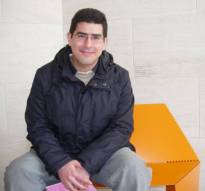Spin-filter scanning tunneling microscopy.
A novel technique for the analysis of spin polarization on magnetic surfaces and spintronic devices
Promotion date: 20. May 2010
Promotors: Prof. Dr. Paul Kelly
Assistant Promotor: Dr. Ron Jansen
| This thesis deals with the development of a versatile technique to measure spin polarization with atomic resolution. Such a technique is useful for characterization of magnetic nanostructures, specifically in relation to spin-polarized transport. The progress of our understanding and control of these structures is directly tied to the development of appropriate magnetic microscopy methods. Recent developments in spintronics and data storage systems, render the study of electronic spin polarization in nanostructures a major point of interest. Therefore a technique that can measure spin polarization is relevant for characterization of spintronic properties of materials. |
Why is it important to develop a new quantifying technique for spin polarization?
We used scanning tunneling microscopy (STM), a technique widely used both in science and in industry. Using STM one can visualize conductive surfaces with atomic resolution. Although there are STM-based techniques to study magnetism at the nanoscale, there is still a need for a generally applicable technique, that can directly quantify electronic spin polarization with high spatial resolution. The technique I worked on offers the possibility to quantify this spin polarization, which can be very important for new functionalities of future electronic circuits, based on the spin of the electron as studied in the field of spintronics.
When in the thesis project did the main results become visible?
In fact, at the beginning of the last year I had some good results. There were several material science issues to be solved before that. I was able to demonstrate the operating principle of the technique and compare it with other magnetic microscopy techniques. The biggest achievement was to build a spintronic device at the apex of an STM tip. This device acts as a sensor on the prepared STM tips that could measure spin polarization. Although more work is necessary to fully develop this technique, the work was recognized with a poster prize and an invited talk at international conferences, which was quite gratifying.
Did you feel part of the Mesa+ community?
Yes, I did. Using the cleanroom facilities and expertise from fellow scientists and technicians, all necessary ingredients were available for me to achieve the final results of this thesis. In this sense Mesa+ is a great institute. It enables one to turn a conceptual idea into a tangible fabrication process or working device, even if it is complex.
How did you develop yourself in Twente, as a scientist and researcher?
Actually, my stay in Twente was longer than the four years of PhD. I also followed my master studies here, as part of the first group of nanotechnology students. I worked on different projects in several research groups which was a good learning experience. During the PhD at the nano-electronics group I worked in a mixture of science and engineering. Being myself an electronics engineer, this experience has helped me to develop a balanced view on research.
What are your future plans?
Right now I am working at the Zernike Institute in Groningen, as a post-doc. I plan to stay two more years here, and then I am going to look for a job probably in Europe, be it in academia or industry, as long as electron transport, research and development are all part of the job.
What is important for Mesa+ to maintain being a strong player in the future?
Mesa+ is on the right track, that’s for sure. In my opinion it would be beneficial to increase the collaboration between different groups a bit more, and to encourage the set-up of more multidisciplinary projects. Also there is still room to involve more of the industry in research programmes. When true interaction takes place between people with different intellectual backgrounds, interesting things might happen.

